 Click the blue text above to subscribe
Click the blue text above to subscribe

Piezoelectric materials are widely used in energy harvesters, vibration accelerometers, electronic skin, human-computer interaction interfaces, and other fields due to their electromechanical conversion capabilities. Polymer piezoelectric materials, represented by polyvinylidene fluoride (PVDF) and its derived copolymers, are favored for their excellent flexibility and ease of processing. However, the lower piezoelectric coefficients of polymer piezoelectric materials compared to inorganic materials such as lead titanate (PZT) and barium titanate (BTO) pose significant obstacles to their application.
To address this issue and enhance the piezoelectric performance of polymer-based piezoelectric materials, Professor Huang Xingyi’s research group at Shanghai Jiao Tong University has innovatively proposed a modulus modulation strategy to prepare high-performance all-organic piezoelectric fiber materials with a core-shell structure. Using a coaxial electrospinning method, they fabricated piezoelectric fibers with a polyvinylidene fluoride-trifluoroethylene copolymer (PVDF-TrFE) shell and a polycarbonate (PC) core, resulting in a core-shell structure (PC@PVDF-TrFE). The rigid PC core enhances the overall modulus of the fibers, and compared to pure PVDF-TrFE fibers, the higher modulus allows the core-shell fibers to generate greater stress under the same strain, which in turn applies greater stress to the outer PVDF-TrFE, resulting in higher piezoelectric output. Additionally, due to the hydrogen bonding interactions between the PVDF-TrFE shell and the PC core, the polarity β phase content of PVDF-TrFE is also increased, thereby enhancing the overall piezoelectric coefficient of the piezoelectric fibers.The piezoelectric coefficient of PC@PVDF-TrFE can reach 49.1 pC N-1, which is 110% higher than that of pure PVDF-TrFE. Based on PC@PVDF-TrFE fibers, piezoelectric energy harvesting devices exhibit excellent output performance, with output voltage and power reaching 126 V and 710 mW m-2, respectively, which is currently the highest value among all-organic piezoelectric materials. Leveraging the excellent performance of piezoelectric fiber materials, they have been used for vibration sensing in power equipment. A wireless transformer vibration signal online monitoring system was constructed using flexible fiber piezoelectric devices, capable of sensitively detecting equipment vibrations below 500 Hz and providing fault warnings.
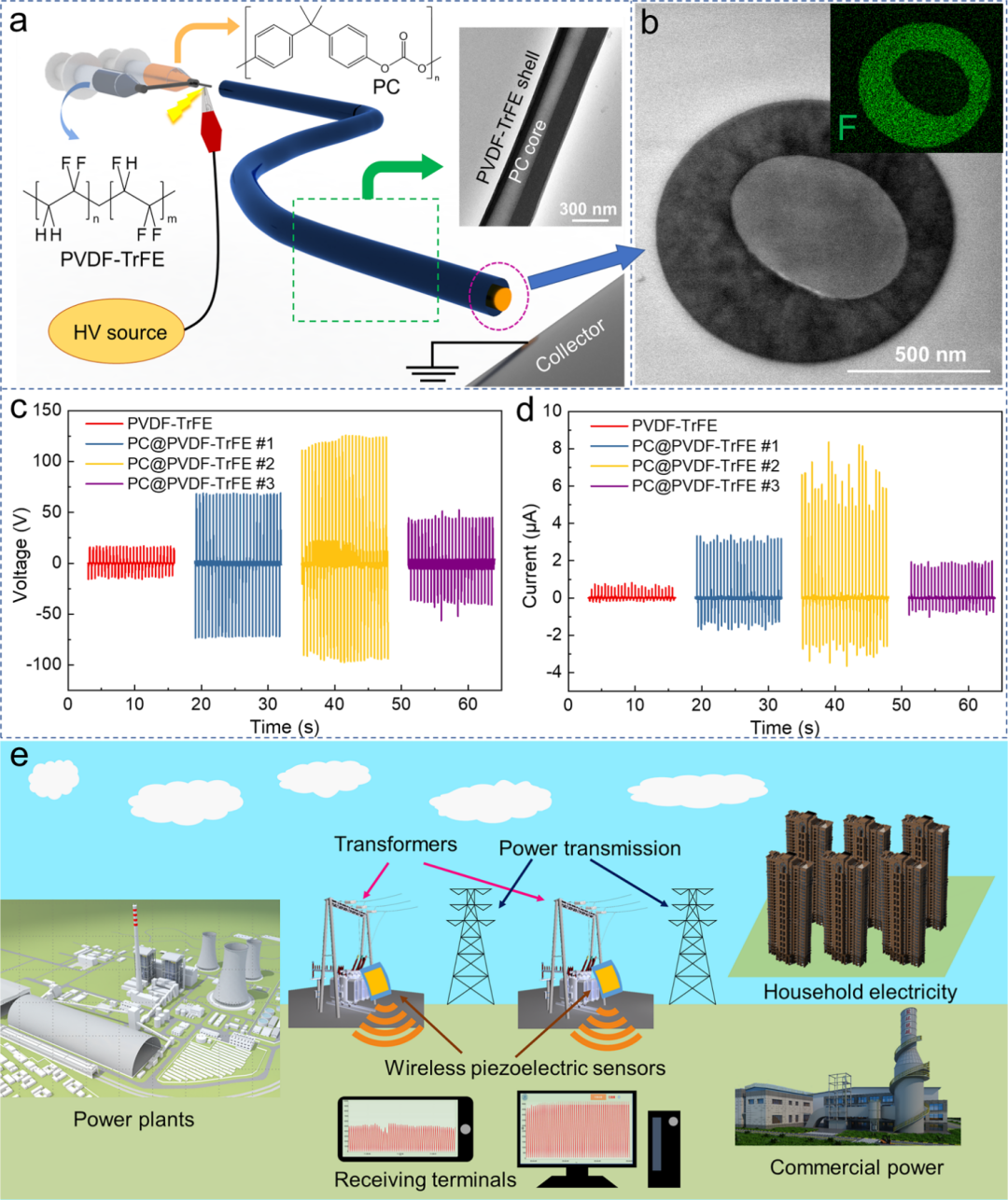
Figure 1 (a), (b) Schematic diagram of the preparation of core-shell fibers and TEM plane and cross-sectional characterization. (c), (d) Comparison of output performance of pure PVDF-TrFE and PC@PVDF-TrFE fiber piezoelectric devices. (e) Schematic diagram of application scenarios for piezoelectric fiber sensor devices.
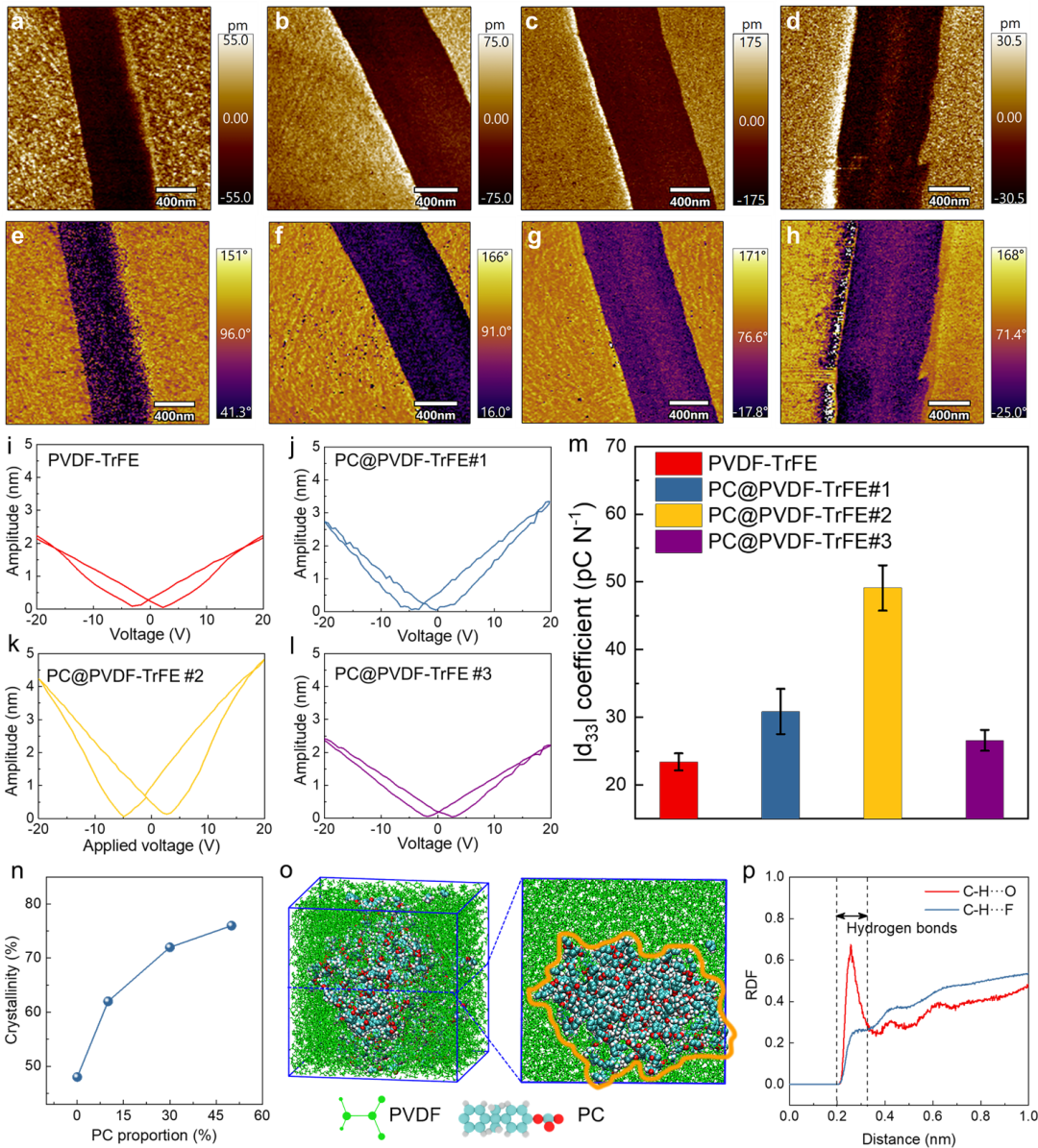
Figure 2 Comprehensive characterization of fiber piezoelectric performance. As shown in Figure 2, the piezoelectric performance of a single fiber was characterized using a piezoelectric force microscope (PFM), and the maximum piezoelectric coefficient of PC@PVDF-TrFE was calculated to reach 49.1 pC N-1. The results of molecular dynamics simulations and crystallinity characterization demonstrated the presence of hydrogen bonds at the interface between PVDF-TrFE and PC, which is the main reason for the enhancement of the piezoelectric coefficient of the core-shell fibers.
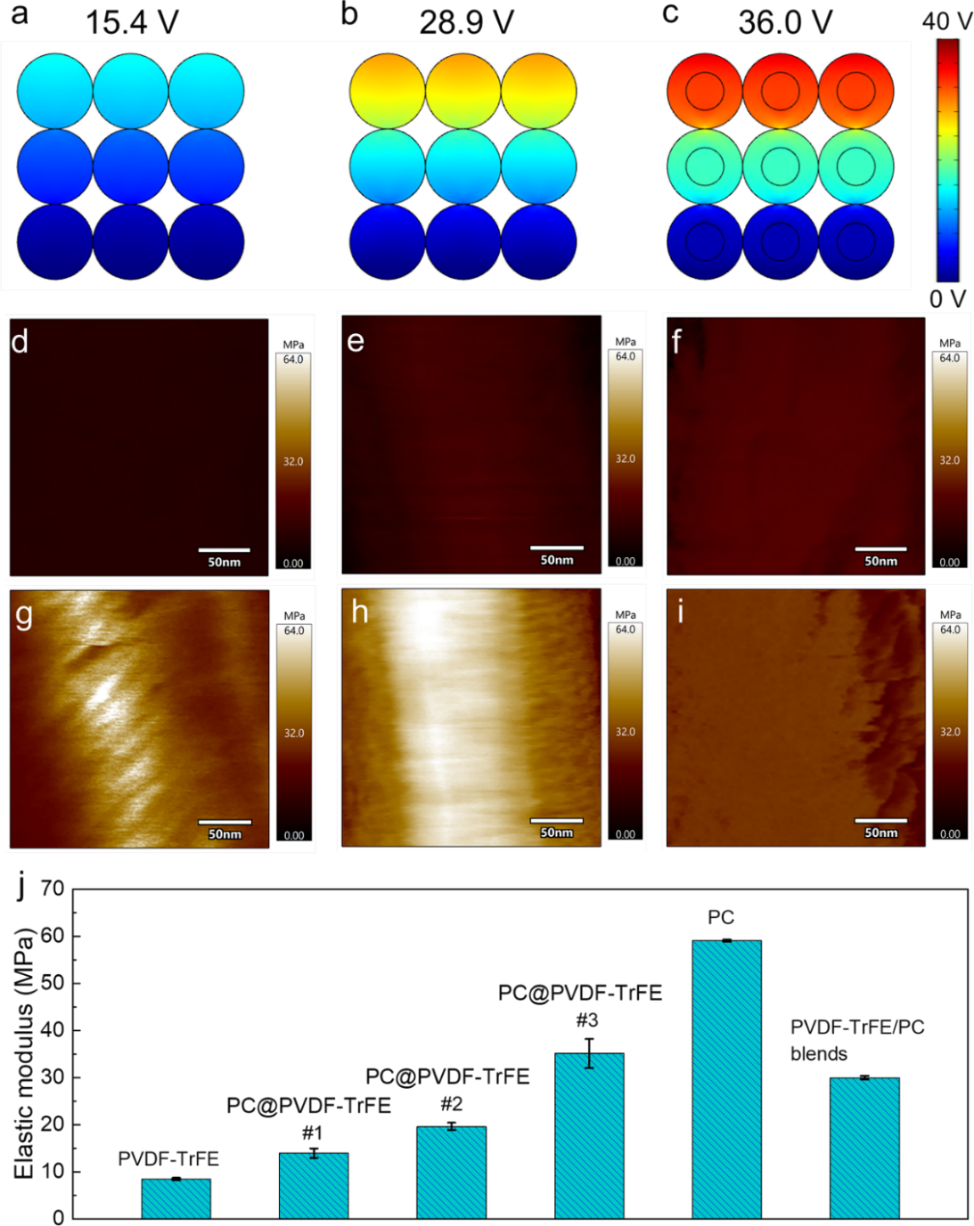
Figure 3 Characterization of the elastic modulus of piezoelectric fibers. First, finite element simulations (COMSOL) demonstrated that the PVDF-TrFE/PC blended fibers with higher modulus and the PC@PVDF-TrFE core-shell fibers can output higher voltage under the same strain compared to pure PVDF-TrFE. Subsequently, the elastic modulus of the fiber materials was characterized using AFM, revealing that as the content of PC in the core-shell fibers increased from 10% to 50%, the elastic modulus of PC@PVDF-TrFE samples increased from 14.0 MPa to 35.1 MPa. Through the characterization of modulus using PFM and AFM, as well as the results from molecular dynamics simulations and finite element simulations, it is clear why PC@PVDF-TrFE exhibits excellent piezoelectricity. On one hand, the hydrogen bonds formed at the interface between PC and PVDF-TrFE increase the polarity β phase content of the fibers, enhancing the piezoelectric coefficient. On the other hand, the rigid PC core enhances the overall modulus of the core-shell fibers, generating greater stress during deformation. Under the combined effects of these two factors, the piezoelectric output of the core-shell structure is significantly improved compared to pure PVDF-TrFE fibers.
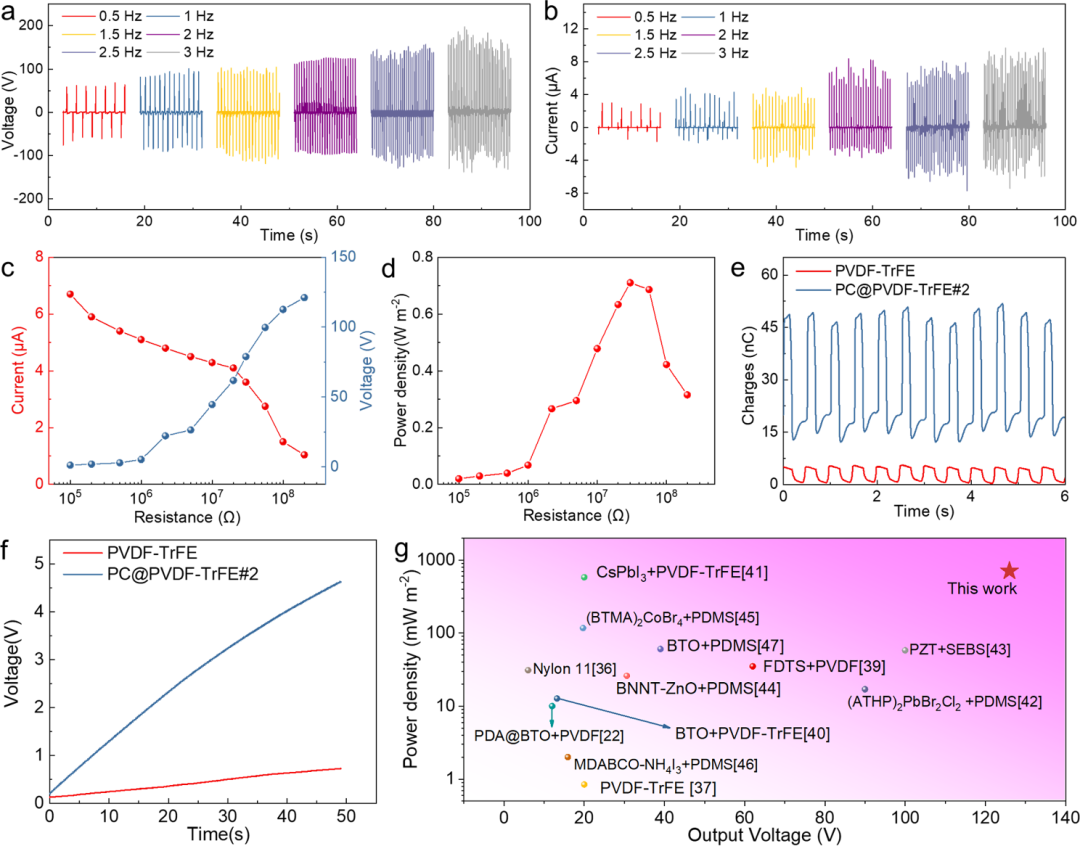
Figure 4 Comprehensive characterization of the output performance of piezoelectric devices based on PC@PVDF-TrFE fibers. It can be seen that the output performance of PC@PVDF-TrFE fibers has significant advantages even compared to composite piezoelectric materials that include inorganic piezoelectric ceramics such as PZT and BTO, and far exceeds traditional organic piezoelectric polymers such as nylon 11 and PVDF-TrFE.
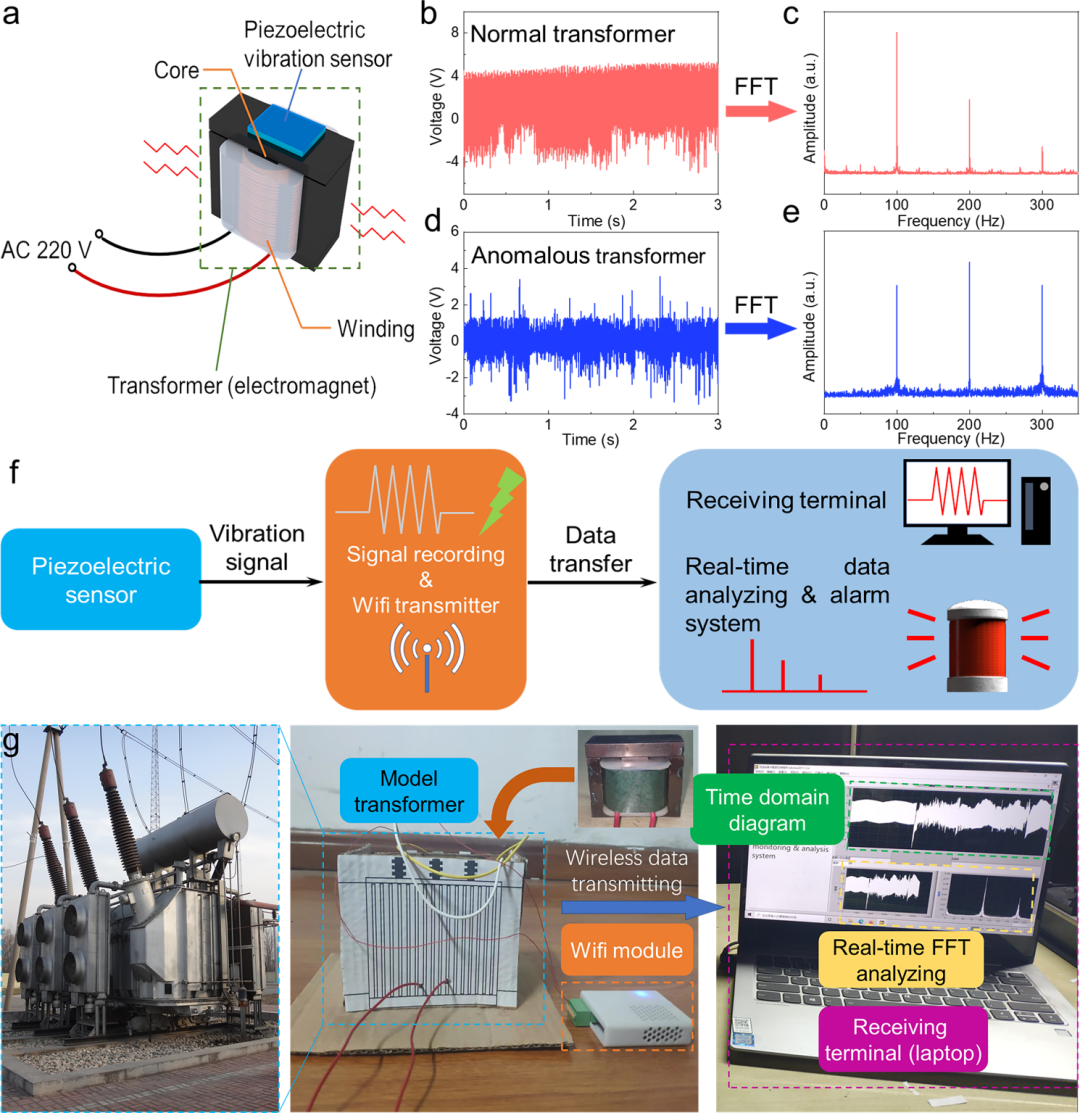
Figure 5 Demonstration of transformer vibration sensing applications based on PC@PVDF-TrFE piezoelectric fibers. The excellent piezoelectric performance of PC@PVDF-TrFE enables it to sensitively detect vibration signals from power equipment, and performing a fast Fourier transform on the raw signals allows for spectral analysis. Using the WIFi module and receiving terminal (computer), wireless transmission and real-time analysis of vibration signals have been achieved. The related results were published in the international journal “Modulus Modulated All-Organic Core-Shell Nanofiber with Remarkable Piezoelectricity for Energy Harvesting and Condition Monitoring” in Nano Letters. Doctoral student Chai Bin from the Electrical Materials and Insulation Research Center at Shanghai Jiao Tong University is the first author of the paper, with Professor Huang Xingyi as the corresponding author, and Professors Sheng Gehao and Wang Yalin also making significant contributions. This research work was supported by funding from the State Grid Corporation’s basic forward-looking project.
Paper link:
https://doi.org/10.1021/acs.nanolett.2c04674
Related progress
Professor Huang Xingyi from Shanghai Jiao Tong University in Science Bulletin: High Thermal Conductivity Electrode Polarized Energy Storage Nanocomposites
Professor Huang Xingyi and Professor Bao Hua’s collaboration in AFM: High Thermal Conductivity Radiation Cooling Insulation Materials
Associate Professor Sun Bin from Qingdao University, along with Professor Huang Xingyi from Shanghai Jiao Tong University and Academician Zhang Tongyi from Shanghai University, made significant progress in flexible wearable devices in Nat. Commun.

This is an original article from Polymer Science. Personal forwarding and sharing are welcome. For publications or media wishing to reprint, please contact: [email protected]

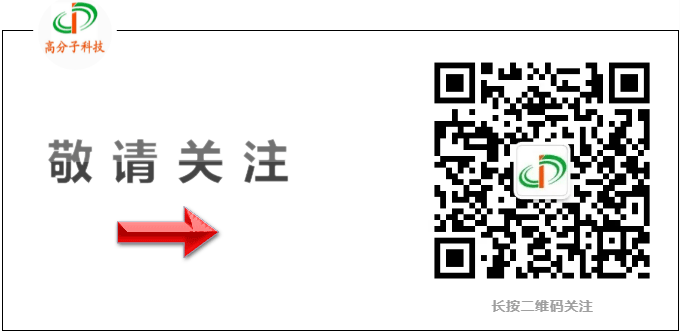
We sincerely invite submissions
Experts and scholars are welcome to provide manuscripts (papers, project introductions, new technologies, academic exchanges, unit news, conference information, recruitment, and enrollment, etc.) to [email protected], and please indicate detailed contact information. Polymer Science® will promptly push and publish on China Polymer Online.
Welcome to join the WeChat group To meet the needs of colleagues in the polymer industry, we have successively opened dozens of special discussion groups, including a group for polymer experts and scholars, covering various fields such as polymer industry technology, entrepreneurs, PhDs, graduate students, media journals, and conference associations, gathering thousands of top experts, scholars, technicians, and entrepreneurs from domestic and foreign universities and research institutes.
To apply for group entry, please first add the review WeChat account PolymerChina (or long press the QR code below), and please be sure to indicate: Polymer + Name + Unit + Title (or Degree) + Field (or Industry), otherwise, it will not be processed. Qualification will be reviewed before entering the relevant professional group.

Click here to read the original text for more information.